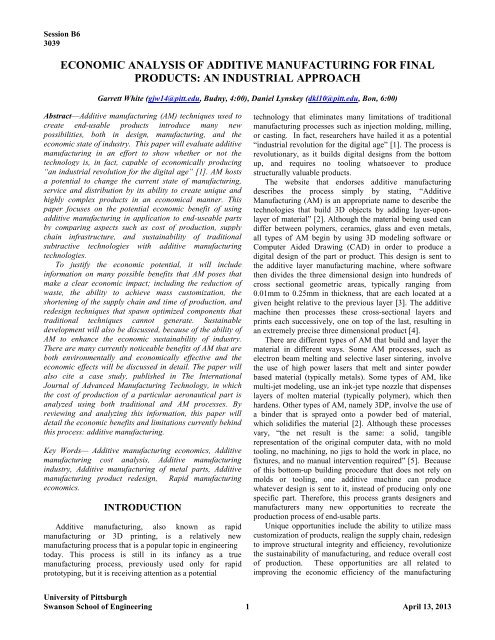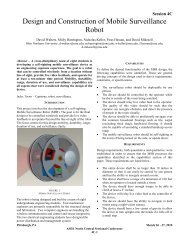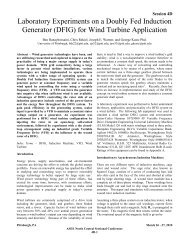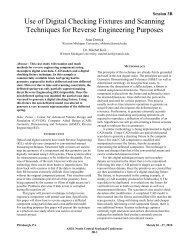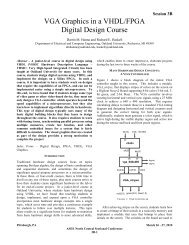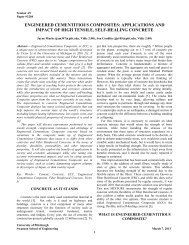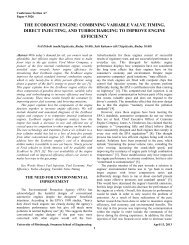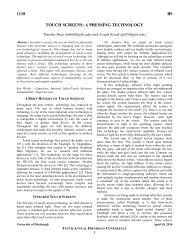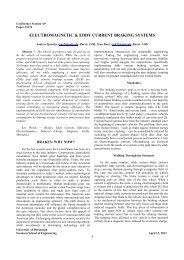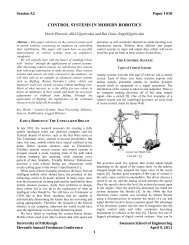economic analysis of additive manufacturing for final products
economic analysis of additive manufacturing for final products
economic analysis of additive manufacturing for final products
You also want an ePaper? Increase the reach of your titles
YUMPU automatically turns print PDFs into web optimized ePapers that Google loves.
Session B6<br />
3039<br />
ECONOMIC ANALYSIS OF ADDITIVE MANUFACTURING FOR FINAL<br />
PRODUCTS: AN INDUSTRIAL APPROACH<br />
Garrett White (gjw14@pitt.edu, Budny, 4:00), Daniel Lynskey (dkl10@pitt.edu, Bon, 6:00)<br />
Abstract—Additive <strong>manufacturing</strong> (AM) techniques used to<br />
create end-usable <strong>products</strong> introduce many new<br />
possibilities, both in design, <strong>manufacturing</strong>, and the<br />
<strong>economic</strong> state <strong>of</strong> industry. This paper will evaluate <strong>additive</strong><br />
<strong>manufacturing</strong> in an ef<strong>for</strong>t to show whether or not the<br />
technology is, in fact, capable <strong>of</strong> <strong>economic</strong>ally producing<br />
“an industrial revolution <strong>for</strong> the digital age” [1]. AM hosts<br />
a potential to change the current state <strong>of</strong> <strong>manufacturing</strong>,<br />
service and distribution by its ability to create unique and<br />
highly complex <strong>products</strong> in an <strong>economic</strong>al manner. This<br />
paper focuses on the potential <strong>economic</strong> benefit <strong>of</strong> using<br />
<strong>additive</strong> <strong>manufacturing</strong> in application to end-useable parts<br />
by comparing aspects such as cost <strong>of</strong> production, supply<br />
chain infrastructure, and sustainability <strong>of</strong> traditional<br />
subtractive technologies with <strong>additive</strong> <strong>manufacturing</strong><br />
technologies.<br />
To justify the <strong>economic</strong> potential, it will include<br />
in<strong>for</strong>mation on many possible benefits that AM poses that<br />
make a clear <strong>economic</strong> impact; including the reduction <strong>of</strong><br />
waste, the ability to achieve mass customization, the<br />
shortening <strong>of</strong> the supply chain and time <strong>of</strong> production, and<br />
redesign techniques that spawn optimized components that<br />
traditional techniques cannot generate. Sustainable<br />
development will also be discussed, because <strong>of</strong> the ability <strong>of</strong><br />
AM to enhance the <strong>economic</strong> sustainability <strong>of</strong> industry.<br />
There are many currently noticeable benefits <strong>of</strong> AM that are<br />
both environmentally and <strong>economic</strong>ally effective and the<br />
<strong>economic</strong> effects will be discussed in detail. The paper will<br />
also cite a case study, published in The International<br />
Journal <strong>of</strong> Advanced Manufacturing Technology, in which<br />
the cost <strong>of</strong> production <strong>of</strong> a particular aeronautical part is<br />
analyzed using both traditional and AM processes. By<br />
reviewing and analyzing this in<strong>for</strong>mation, this paper will<br />
detail the <strong>economic</strong> benefits and limitations currently behind<br />
this process: <strong>additive</strong> <strong>manufacturing</strong>.<br />
Key Words— Additive <strong>manufacturing</strong> <strong>economic</strong>s, Additive<br />
<strong>manufacturing</strong> cost <strong>analysis</strong>, Additive <strong>manufacturing</strong><br />
industry, Additive <strong>manufacturing</strong> <strong>of</strong> metal parts, Additive<br />
<strong>manufacturing</strong> product redesign, Rapid <strong>manufacturing</strong><br />
<strong>economic</strong>s.<br />
INTRODUCTION<br />
Additive <strong>manufacturing</strong>, also known as rapid<br />
<strong>manufacturing</strong> or 3D printing, is a relatively new<br />
<strong>manufacturing</strong> process that is a popular topic in engineering<br />
today. This process is still in its infancy as a true<br />
<strong>manufacturing</strong> process, previously used only <strong>for</strong> rapid<br />
prototyping, but it is receiving attention as a potential<br />
technology that eliminates many limitations <strong>of</strong> traditional<br />
<strong>manufacturing</strong> processes such as injection molding, milling,<br />
or casting. In fact, researchers have hailed it as a potential<br />
“industrial revolution <strong>for</strong> the digital age” [1]. The process is<br />
revolutionary, as it builds digital designs from the bottom<br />
up, and requires no tooling whatsoever to produce<br />
structurally valuable <strong>products</strong>.<br />
The website that endorses <strong>additive</strong> <strong>manufacturing</strong><br />
describes the process simply by stating, “Additive<br />
Manufacturing (AM) is an appropriate name to describe the<br />
technologies that build 3D objects by adding layer-uponlayer<br />
<strong>of</strong> material” [2]. Although the material being used can<br />
differ between polymers, ceramics, glass and even metals,<br />
all types <strong>of</strong> AM begin by using 3D modeling s<strong>of</strong>tware or<br />
Computer Aided Drawing (CAD) in order to produce a<br />
digital design <strong>of</strong> the part or product. This design is sent to<br />
the <strong>additive</strong> layer <strong>manufacturing</strong> machine, where s<strong>of</strong>tware<br />
then divides the three dimensional design into hundreds <strong>of</strong><br />
cross sectional geometric areas, typically ranging from<br />
0.01mm to 0.25mm in thickness, that are each located at a<br />
given height relative to the previous layer [3]. The <strong>additive</strong><br />
machine then processes these cross-sectional layers and<br />
prints each successively, one on top <strong>of</strong> the last, resulting in<br />
an extremely precise three dimensional product [4].<br />
There are different types <strong>of</strong> AM that build and layer the<br />
material in different ways. Some AM processes, such as<br />
electron beam melting and selective laser sintering, involve<br />
the use <strong>of</strong> high power lasers that melt and sinter powder<br />
based material (typically metals). Some types <strong>of</strong> AM, like<br />
multi-jet modeling, use an ink-jet type nozzle that dispenses<br />
layers <strong>of</strong> molten material (typically polymer), which then<br />
hardens. Other types <strong>of</strong> AM, namely 3DP, involve the use <strong>of</strong><br />
a binder that is sprayed onto a powder bed <strong>of</strong> material,<br />
which solidifies the material [2]. Although these processes<br />
vary, “the net result is the same: a solid, tangible<br />
representation <strong>of</strong> the original computer data, with no mold<br />
tooling, no machining, no jigs to hold the work in place, no<br />
fixtures, and no manual intervention required” [5]. Because<br />
<strong>of</strong> this bottom-up building procedure that does not rely on<br />
molds or tooling, one <strong>additive</strong> machine can produce<br />
whatever design is sent to it, instead <strong>of</strong> producing only one<br />
specific part. There<strong>for</strong>e, this process grants designers and<br />
manufacturers many new opportunities to recreate the<br />
production process <strong>of</strong> end-usable parts.<br />
Unique opportunities include the ability to utilize mass<br />
customization <strong>of</strong> <strong>products</strong>, realign the supply chain, redesign<br />
to improve structural integrity and efficiency, revolutionize<br />
the sustainability <strong>of</strong> <strong>manufacturing</strong>, and reduce overall cost<br />
<strong>of</strong> production. These opportunities are all related to<br />
improving the <strong>economic</strong> efficiency <strong>of</strong> the <strong>manufacturing</strong><br />
University <strong>of</strong> Pittsburgh<br />
Swanson School <strong>of</strong> Engineering 1 April 13, 2013
Garrett White<br />
Daniel Lynskey<br />
process; one <strong>of</strong> the main goals <strong>of</strong> Industrial engineers<br />
everywhere. In this case, the improved <strong>economic</strong> aspects<br />
include not only monetary costs, but also the production, and<br />
distribution <strong>of</strong> these goods. AM introduces the ability to use<br />
mass customization in a way that no traditional method has<br />
ever allowed. AM also creates flexibility in another focus <strong>of</strong><br />
industrial engineering, the supply chain. AM processes also<br />
encourage product redesign techniques that can noticeably<br />
change the amount <strong>of</strong> material consumed, and can also<br />
improve structural integrity <strong>of</strong> each part. All <strong>of</strong> these<br />
changes to traditional <strong>manufacturing</strong> techniques limitations<br />
obviously also reduce a vital portion <strong>of</strong> <strong>economic</strong> efficiency-<br />
- the cost <strong>of</strong> production. Along with affecting <strong>economic</strong><br />
aspects <strong>of</strong> the industry, AM also enhances the sustainability<br />
<strong>of</strong> the traditional <strong>manufacturing</strong> process, in environmental,<br />
social, and <strong>economic</strong> dimensions. While AM is currently not<br />
a perfected process, the potential benefits it could bring to<br />
the <strong>economic</strong>s <strong>of</strong> the <strong>manufacturing</strong> process are certainly<br />
noticeable.<br />
ADDITIVE MANUFACTURING ENABLING<br />
MASS CUSTOMIZATION OF PRODUCTS<br />
One <strong>of</strong> the benefits <strong>of</strong> AM is that the <strong>manufacturing</strong><br />
process does not involve the use <strong>of</strong> molds or extra tooling to<br />
create different <strong>products</strong>. The AM process involves taking a<br />
CAD design <strong>of</strong> the product and printing it out layer by layer,<br />
building the product from the bottom up. On the other hand,<br />
when using typical traditional <strong>manufacturing</strong> techniques,<br />
such as die casting or injection molding, to create a new<br />
product, the manufacturers must first create a new mold.<br />
Since AM does not require different molds <strong>for</strong> different<br />
<strong>products</strong>, manufacturers find a unique capability to utilize<br />
varying designs on the same AM machine. In effect, AM<br />
technologies could change the paradigm <strong>for</strong> <strong>manufacturing</strong>,<br />
moving away from mass production in factories and high<br />
costs, to mass customization and distributed manufacture<br />
[6]. Mass customization is the ability to create<br />
individualized or personally customized <strong>products</strong> without<br />
increasing the cost or time <strong>of</strong> production. The impact <strong>of</strong><br />
mass customization on production is extensive, and “could<br />
be thought <strong>of</strong> as a key driver <strong>for</strong> the agile supply chain<br />
paradigms prominence in <strong>manufacturing</strong> business thinking<br />
worldwide” [7]. Consumers today are consistently<br />
demanding new, quality, and unique <strong>products</strong>. The ability to<br />
change each product to consumer desires or needs greatly<br />
increases the buyer’s sense <strong>of</strong> satisfaction in the product. In<br />
some cases, however, application <strong>of</strong> mass customization<br />
satisfies more than the customer’s desire <strong>for</strong> individualized<br />
<strong>products</strong>, and creates parts <strong>of</strong> higher quality <strong>for</strong> personal use.<br />
Applications <strong>of</strong> mass customization in industry today<br />
The capability <strong>of</strong> producing low-cost, high variety<br />
<strong>products</strong> has become increasingly important in many product<br />
areas, such as the western automobile industry. In order to<br />
“compete with lower-cost imported vehicles, western<br />
manufacturers have found it necessary first to change their<br />
operational model to compete with far east suppliers and<br />
secondly seek competitive advantage in the area <strong>of</strong> mass<br />
customization” [7]. With AM, consumers could theoretically<br />
request specific designs <strong>for</strong> their vehicle to the<br />
manufacturers, who can then apply these designs to the<br />
structure <strong>of</strong> the vehicle. It would not require the production<br />
<strong>of</strong> a new mold, lowering cost and saving resources.<br />
However, there are current limitations to this idea.<br />
Researchers at Loughborough University in the UK note<br />
that, “the constraint <strong>of</strong> the materials that are used to produce<br />
a tailored product means that currently, it would not be<br />
possible to produce a one <strong>of</strong>f car in the same time as a mass<br />
custom vehicle at the same price” [7]. Mass customization<br />
with <strong>additive</strong> <strong>manufacturing</strong> also has several medical<br />
applications, being used <strong>for</strong> the creation <strong>of</strong> custom medical<br />
devices. One example is the production <strong>of</strong> custom fitted<br />
hearing aids. Normally, these devices must be handcrafted<br />
by a skilled technician, made to fit each patient. However,<br />
with <strong>additive</strong> <strong>manufacturing</strong>, it is possible to make a wax<br />
mold <strong>of</strong> the patient’s ear, and use a 3D scanner to digitalize<br />
the impression, creating a digital model which can then be<br />
printed. This same idea is viable in application to the dental<br />
industry, which also relies heavily on custom fit dentures,<br />
implants, retainers and other pieces. AM technology is also<br />
being used in tissue engineering, and even prosthetics<br />
development [4]. Although the application <strong>of</strong> AM in these<br />
fields is a very important topic, there is simply too much<br />
in<strong>for</strong>mation on the different processes <strong>for</strong> this paper to<br />
cover. Mass customization brings about an enormous change<br />
in the traditional <strong>manufacturing</strong> process, and has many<br />
benefits. Each <strong>of</strong> these applications enhances consumer<br />
satisfaction, either because <strong>of</strong> personal desire, or health<br />
improvement. Because AM does not require the production<br />
<strong>of</strong> new molds, and can produce items on site, it can save<br />
businesses time and money, and has a considerable effect on<br />
the supply chain.<br />
ADDITIVE MANUFACTURING<br />
AFFECTING THE SUPPLY CHAIN<br />
One <strong>of</strong> the main focuses <strong>of</strong> industrial engineering is the<br />
idea <strong>of</strong> supply chain management. Supply chain<br />
management is focused on the storage, movement, and<br />
distribution <strong>of</strong> raw material, mid-process parts, and endusable<br />
parts. A sustainable supply chain is one that<br />
eliminates waste in each <strong>of</strong> these aspects, and AM has the<br />
ability to create such a supply chain. Two types <strong>of</strong> supply<br />
chains that are heavily discussed in industrial engineering<br />
today include the lean supply chain, and the agile supply<br />
chain. Firstly, “The lean paradigm <strong>of</strong> supply chain<br />
management encompasses the idea <strong>of</strong> reducing waste<br />
throughout the supply chain” [7]. In most cases, this<br />
2
Garrett White<br />
Daniel Lynskey<br />
reduction <strong>of</strong> waste involves the reduction <strong>of</strong> time <strong>of</strong><br />
production and distribution, material used, or cost <strong>of</strong><br />
production. The lean supply chain is typically used <strong>for</strong><br />
commodities and <strong>products</strong> that are continually in demand.<br />
The next type, the agile paradigm, “means using market<br />
knowledge and a virtual corporation to exploit pr<strong>of</strong>itable<br />
opportunities in a volatile market place” [7]. In other words,<br />
the agile supply chain focuses greatly on reduction <strong>of</strong> lead<br />
time <strong>of</strong> production, and is used <strong>for</strong> fashionable or trending<br />
<strong>products</strong> that have a short product life cycle.<br />
Impact on agile supply chain management<br />
Additive <strong>manufacturing</strong> shows potential to be extremely<br />
disruptive to these two supply chain paradigms. First, <strong>for</strong> the<br />
agile supply chain paradigm, AM benefits are quite<br />
realizable. In the agile supply chain, it is essential that<br />
manufacturers are able to quickly respond to demand<br />
change, whether that includes volume change or product<br />
change [8]. AM can potentially condense lead times <strong>of</strong><br />
production, because <strong>of</strong> the machines’ ability to produce any<br />
part by processing a digital file, and building from the<br />
bottom up. This means, just as in the idea <strong>of</strong> mass<br />
customization, that manufacturers can produce a multitude<br />
<strong>of</strong> different parts from one machine. In effect, whichever<br />
part is required can be locally manufactured, eliminating the<br />
need to outsource the production <strong>of</strong> specialty parts. This, in<br />
turn, reduces long lead times <strong>of</strong> transportation. AM also<br />
reduces time <strong>of</strong> production in a more literal way because <strong>of</strong><br />
its ability to begin producing a part immediately after the<br />
CAD design <strong>of</strong> the product has been finished. Using<br />
traditional methods to create a new product typically<br />
requires weeks <strong>of</strong> time in order to produce the necessary<br />
tooling be<strong>for</strong>e production can even begin [9]. Furthermore,<br />
AM presents the idea <strong>of</strong> <strong>products</strong> that can essentially be<br />
made-to-order, which is extremely valuable <strong>for</strong> <strong>products</strong> that<br />
are volatile. Instead <strong>of</strong> traditional <strong>manufacturing</strong> techniques<br />
that require large batch sizes to become <strong>economic</strong>al, AM can<br />
<strong>economic</strong>ally produce batch sizes <strong>of</strong> one (or low to medium<br />
volume), reducing the possibility <strong>of</strong> producing a surplus <strong>of</strong><br />
<strong>products</strong>.<br />
Impact on lean supply chain management<br />
Benefits regarding the lean paradigm <strong>of</strong> supply chain<br />
management are also tangible with the use <strong>of</strong> AM. As<br />
previously mentioned, the lean paradigm is chiefly<br />
concerned with the reduction <strong>of</strong> waste in material, cost, and<br />
time <strong>of</strong> production. Furthermore, in traditional<br />
<strong>manufacturing</strong> methods one <strong>of</strong> the greatest costs incurred by<br />
the producer is due to the cost <strong>of</strong> the tooling. Eliminating the<br />
need <strong>for</strong> tooling parts drastically reduces the overall cost <strong>of</strong><br />
production, which effectively reduces waste <strong>of</strong> money.<br />
Along with affecting the agile supply chain, relocation <strong>of</strong><br />
manufacture also affects the lean supply chain. The ability to<br />
produce many different specialized <strong>products</strong> from one<br />
machine is space saving, and it eliminates the need <strong>for</strong><br />
international export or import. This idea can drastically<br />
reduce the cost <strong>of</strong> logistics, subsequently reducing the cost<br />
<strong>of</strong> production. The reduction <strong>of</strong> wasted material is also<br />
conceivable with <strong>additive</strong> <strong>manufacturing</strong> processes, because<br />
scrap rates are greatly reduced. Additive layering machines<br />
only use the amount <strong>of</strong> material that is required in the<br />
finished product, unlike traditional subtractive techniques, in<br />
which the product is cut out <strong>of</strong> a block <strong>of</strong> excess material.<br />
Reducing wasted material has connection to sustainability in<br />
the most literal sense, because this material is being<br />
preserved. Yet another effect AM could bring to the lean<br />
supply chain is in an area in which <strong>manufacturing</strong> companies<br />
<strong>of</strong>ten find excess and unnecessary cost and waste: the<br />
storage <strong>of</strong> spare and stock parts.<br />
Reduction <strong>of</strong> stockpile size<br />
Additive <strong>manufacturing</strong>’s ability to create a batch size <strong>of</strong><br />
one is a unique ability to this technology that could truly<br />
make an important impact. One inherent cost that<br />
manufacturers face today is the cost required to keep a<br />
stockpile <strong>of</strong> spare parts. Particularly in the aerospace<br />
industry where, “nothing is more expensive than an airliner<br />
on the ground”, stock <strong>of</strong> spare parts is very important [10].<br />
However, most large aircraft made today can involve up to 4<br />
million components, and warehouses large enough to hold<br />
these parts in stock are rare, and very expensive. For<br />
example, The Material Support Centre <strong>of</strong> Airbus Industrie in<br />
Hamburg-Fuhlsbüttel has a warehouse capacity <strong>of</strong> 36,000<br />
square meters [10]. Although it is important to have spare<br />
parts on hand <strong>for</strong> timely repair <strong>of</strong> equipment, many <strong>of</strong> these<br />
parts are very infrequently used, and lead to a waste <strong>of</strong><br />
warehouse space and logistics costs. Furthermore, in the<br />
aircraft industry, many parts become obsolete with the<br />
innovation <strong>of</strong> new equipment, or have a short shelf-life.<br />
Another large problem in the aircraft industry is that<br />
once a new plane makes its maiden flight, most <strong>of</strong> its<br />
geometries change due to different conditions in the sky<br />
[11]. This means that stock parts are occasionally unusable.<br />
The ability to create different parts on demand would<br />
seemingly eliminate the restrictions <strong>of</strong> stock parts. However,<br />
traditional <strong>manufacturing</strong> techniques are <strong>economic</strong>ally<br />
inefficient <strong>for</strong> this, as these machines have large start-up<br />
cost, and require expensive tooling. This is where AM<br />
techniques are being implemented, because <strong>of</strong> their unique<br />
ability to produce multiple different parts on one machine.<br />
The only material stock then required is the raw material that<br />
is required to produce the part [7]. Instead <strong>of</strong> requiring an<br />
expansive stock <strong>of</strong> parts that can easily go unexploited,<br />
manufacturers using AM can ‘hold a stock’ <strong>of</strong> digital CAD<br />
files, which can be used at any time to create the part needed<br />
in an <strong>economic</strong>al and timely manner. These CAD files can<br />
also be edited to compensate <strong>for</strong> unique properties <strong>of</strong><br />
individual planes. The unique abilities that AM processes<br />
3
Garrett White<br />
Daniel Lynskey<br />
provide can greatly reduce this inherent expense, once again<br />
leading to a lower overall cost <strong>of</strong> production.<br />
UTILIZING PRODUCT REDESIGN IN<br />
CREATING PRODUCTS<br />
One <strong>of</strong> the most innovative benefits <strong>of</strong> <strong>additive</strong><br />
<strong>manufacturing</strong> is its ability to create complex geometric<br />
structures without wasting any raw materials. As discussed<br />
earlier, one <strong>of</strong> the major problems with subtractive<br />
<strong>manufacturing</strong> is the need <strong>for</strong> use <strong>of</strong> molds, or a billet <strong>of</strong><br />
excess material. In order to create a structure using<br />
traditional <strong>manufacturing</strong> techniques such as casting or<br />
injection molding, the raw materials are <strong>for</strong>med in a mold<br />
and then some <strong>of</strong> the material must be removed. The need to<br />
be able to remove the part from the mold creates a limitation<br />
<strong>for</strong> molding methods. One such limitation is that, “the part<br />
must have slightly outward sloping surfaces (called positive<br />
draft), as inward sloping surfaces would essentially lock the<br />
part to the mold like a dovetail making it impossible to remove”<br />
[4]. Molds must also typically allow <strong>for</strong> mold division lines<br />
and excess scrap, which must typically then be buffered out <strong>of</strong><br />
the <strong>final</strong> product. Along with this, when product designs change<br />
to a more complex and functional shapes, this means the mold<br />
or tooling must also change, causing great cost. Traditionally<br />
built <strong>products</strong> also find limitation in complexity <strong>of</strong> geometries.<br />
For example, many parts used in engines require significant use<br />
<strong>of</strong> cooling channels. Using traditional methods, “cooling<br />
channels could only be drilled through molds in few key<br />
places and only in straight lines”; creating corners with<br />
inefficient fluid flow [4]. Traditional methods are sub-par<br />
in creating any sort <strong>of</strong> internal geometry, because <strong>of</strong> the need<br />
to eventually remove molding pieces or tooling holds. These<br />
limitations can seemingly be eliminated by the free<strong>for</strong>m<br />
abilities <strong>of</strong> AM technologies, building each part from the<br />
bottom up.<br />
Producing complex geometries<br />
The goals <strong>of</strong> design <strong>for</strong> <strong>additive</strong> <strong>manufacturing</strong> can be<br />
described as to “maximize product per<strong>for</strong>mance through the<br />
synthesis <strong>of</strong> shapes, sizes, hierarchical structures, and<br />
material compositions, subject to the capabilities <strong>of</strong> AM<br />
technologies.” [9] There are a few ways in which AM could<br />
help to reach these goals. Firstly, with AM “it is possible to<br />
design part with unlimited complexity, allowing twisted and<br />
contorted shapes, blind holes and screw, and very high<br />
strength-to-weight ratio” [9]. As mentioned above,<br />
traditional methods are <strong>of</strong>ten limited by straight line drilling,<br />
which results in inefficient cooling channels. Since AM<br />
methods build from bottom up, optimized free-<strong>for</strong>m internal<br />
channels and structures can be produced. Ideally shaped<br />
cooling channels can be integrated into design <strong>for</strong> higher<br />
product per<strong>for</strong>mance. Also, with AM it is possible to<br />
combine separate parts into an integrated assembly, which<br />
minimizes the part count while making assembly simpler<br />
and faster. This idea involves the integration <strong>of</strong> pumps, fluid<br />
channels, pistons, and perhaps even electronic pieces,<br />
directly into the core <strong>of</strong> the part, without the need to<br />
manually assemble the part. One other application <strong>of</strong> AM<br />
abilities to create very precise and free <strong>for</strong>m structures can<br />
be shown with a simple example. “When complex organic<br />
structures such as wood or bone are examined it is striking<br />
how structural material is only used where it is needed (i.e.<br />
where there is a stressor)” [4]. There is internal empty<br />
space, although the integrity <strong>of</strong> the entire piece remains, as it<br />
still functions as a whole. Although this idea could never be<br />
realized by traditional techniques, it can be applied to the<br />
redesign <strong>of</strong> AM parts, with the use <strong>of</strong> internal lattice<br />
structures. Commonly used in the design <strong>of</strong> bridges, lattice<br />
structures involve geometric patterns, such as hexagonal (or<br />
honey-comb) structures, crossing structures, or triangular<br />
structures, that provide support only in areas that the product<br />
is under stress. These internal lattices can potentially greatly<br />
reduce the amount <strong>of</strong> material consumed, while upholding or<br />
even improving the strength <strong>of</strong> the structure as a whole.<br />
Lightweighting <strong>of</strong> parts<br />
Product lightweighting is the idea <strong>of</strong> <strong>manufacturing</strong> a<br />
product by using as little raw material as possible, but still<br />
maintaining the structural integrity <strong>of</strong> that product. As<br />
stated be<strong>for</strong>e, AM can create highly complex geometric<br />
structures, such as internal lattices, that can reduce the<br />
amount <strong>of</strong> consumed material. By applying this technique<br />
manufacturers can save a large amount <strong>of</strong> material used,<br />
extending the amount <strong>of</strong> available resources [12]. Since<br />
there is less material being used, it takes less time to process<br />
the material thus resulting in faster build times. A higher<br />
throughput is one benefit <strong>of</strong> this technique [12]. Also, if<br />
these lightweight parts are used in automobiles or aircraft,<br />
one can notice a drastic reduction in fuel consumption. A<br />
lighter vehicle requires less fuel, which is a focus <strong>of</strong> most<br />
car and aerospace manufacturers today. Fuel efficiency is an<br />
important aspect in sustainability. A fuel-efficient vehicle is<br />
not only good <strong>for</strong> the environment, but it will also save the<br />
consumer money, and help to preserve our fuel sources <strong>for</strong><br />
as long as possible.<br />
ADDITIVE MANUFACTURING AS A<br />
SUSTAINABLE PROCESS<br />
Sustainability is an extremely important topic in modern<br />
engineering ethics. It is a broad topic, but can basically be<br />
described as getting as much use out <strong>of</strong> as little resources as<br />
possible. It is said that in order to achieve truly sustainable<br />
product design, the <strong>manufacturing</strong> process must consider<br />
<strong>economic</strong>s, environmental awareness, and social<br />
sustainability. An ideal product is one that involves all three<br />
<strong>of</strong> these areas <strong>of</strong> sustainability [3]. With the help <strong>of</strong> AM,<br />
such a product can be created.<br />
4
Garrett White<br />
Daniel Lynskey<br />
Impacts on environmental sustainability<br />
One <strong>of</strong> the main focuses <strong>of</strong> the sustainable movement<br />
today is on the environment. Above all, sustainability<br />
focuses on preserving a healthy environment that will allow<br />
human life to continue flourishing. Attempting to create<br />
such an environment while also developing new<br />
technologies involves the reduction <strong>of</strong> energy consumption,<br />
and material consumption. AM machines have the potential<br />
to reduce the amount <strong>of</strong> energy used in the <strong>manufacturing</strong><br />
process. First <strong>of</strong> all, as previously mentioned, having a rapid<br />
<strong>manufacturing</strong> machine on site eliminates the need <strong>for</strong><br />
transportation, there<strong>for</strong>e greatly reducing the amount <strong>of</strong> fuel<br />
used. Even if the AM machine cannot be located on site, if<br />
it is being used to produce light weight <strong>products</strong> it will be<br />
significantly more energy efficient to transport the items<br />
because “lighter structures require less energy to move”<br />
[12]. The United States Department <strong>of</strong> Energy, “anticipates<br />
that <strong>additive</strong> processes would be able to save more than 50%<br />
energy use compared to today’s ‘subtractive’ <strong>manufacturing</strong><br />
processes” [13]. It is also stated that typical subtractive<br />
methods such as CNC (computer numerical control) milling<br />
<strong>of</strong>ten find scrap rates as high as 95% when milling from a<br />
block <strong>of</strong> existing material [14]. This number can be<br />
significantly reduced by the bottom up approach <strong>of</strong> AM. The<br />
goal <strong>of</strong> product redesign <strong>for</strong> AM is to recreate <strong>products</strong> in<br />
the most efficient ways possible. This can be done by<br />
utilizing AM abilities to create complex interior structures<br />
and reducing the amount <strong>of</strong> waste in the process. Since,<br />
ultimately, less material is used, AM can prove to be very<br />
cost effective.<br />
Impacts on social sustainability<br />
The social dimension <strong>of</strong> sustainability involves<br />
improving the quality <strong>of</strong> life <strong>of</strong> humans, through healthrelated<br />
advancements, increased consumer satisfaction, and<br />
financial improvement. Additive <strong>manufacturing</strong> poses the<br />
ability to make changes to each <strong>of</strong> these realms. First, in<br />
health-related fields, AM shows perhaps even more promise<br />
than one would immediately think. Although not discussed<br />
at length previously in this paper, AM does possess unique<br />
capabilities to produce very high quality devices <strong>for</strong> human<br />
health improvement. In the Bioengineering field, AM is<br />
currently being researched as a possible means to create very<br />
high quality scaffolds, <strong>for</strong> skin and organ regeneration.<br />
Scaffolding requires very precise structure, which AM can<br />
produce unlike any other <strong>manufacturing</strong> process be<strong>for</strong>e. On<br />
top <strong>of</strong> this, AM is also being used <strong>for</strong> custom-fit prosthetics,<br />
because <strong>of</strong> its ability to create unique <strong>products</strong>. Along with<br />
prosthetics, other medical devices, such as custom-fit<br />
hearing aids, orthopedic implants, and dental braces [3].<br />
Beyond medical advances, AM also provides the ability to<br />
greatly change customer satisfaction. As previously<br />
mentioned, “consumers are becoming increasingly refined in<br />
their tastes and desires <strong>for</strong> new <strong>products</strong>” [7]. AM processes<br />
make mass customization viable, which would obviously<br />
greatly impact a customer’s sense <strong>of</strong> satisfaction. Most<br />
consumers typically enjoy individualized <strong>products</strong> that are<br />
geared towards their own desires. Since AM machines<br />
require only a 3D digital model <strong>of</strong> the product to create it, it<br />
is even possible <strong>for</strong> consumers to become their own<br />
designers. This is a vast concept that would revolutionize<br />
consumer satisfaction. Increased customer satisfaction not<br />
only benefits consumers, but also benefits the producers,<br />
because <strong>of</strong> potential increase in sales. Increase in sales is<br />
something that all producers are currently striving <strong>for</strong>, in an<br />
attempt to stabilize the American economy.<br />
Impacts on <strong>economic</strong> sustainability<br />
Sustainable <strong>economic</strong>s are yet another focus <strong>of</strong> the<br />
sustainability motion, and nearly all other aspects <strong>of</strong><br />
sustainability can be indirectly connected to <strong>economic</strong>s, as<br />
well. The <strong>economic</strong> dimension <strong>of</strong> sustainability involves<br />
present actions that will allow <strong>for</strong> future generations to enjoy<br />
equal or greater wealth, welfare, and consumption abilities.<br />
AM is perhaps most disruptive here, because <strong>of</strong> its ability to<br />
revolutionize <strong>manufacturing</strong> <strong>economic</strong>s. Each <strong>of</strong> the topics<br />
previously mentioned in this paper discuss some <strong>of</strong> the<br />
<strong>economic</strong> changes AM brings about. These changes would<br />
be effective <strong>for</strong> the long-run <strong>of</strong> the <strong>manufacturing</strong> paradigm<br />
we see today. As far as wealth preservation is concerned,<br />
AM also shows the ability to greatly change overall cost <strong>of</strong><br />
production.<br />
COST ANALYSIS OF ADDITIVE<br />
MANUFACTURING<br />
The previous sections in this paper focus on effects that<br />
<strong>additive</strong> <strong>manufacturing</strong> <strong>of</strong> end-usable parts could bring to<br />
the economy <strong>of</strong> an industry. Each <strong>of</strong> these topics has been<br />
related to the production and distribution <strong>of</strong> parts, but they<br />
each also have connection to the actual cost <strong>of</strong> production.<br />
For example, using mass customization techniques in AM<br />
production leads to a higher rate <strong>of</strong> customer satisfaction [7].<br />
Although customer satisfaction does not affect the cost <strong>of</strong><br />
production <strong>of</strong> each part, it does lead to more purchases,<br />
which obviously leads to more revenue <strong>for</strong> the producer.<br />
This revenue then allows the manufacturer to pay <strong>for</strong> the<br />
costs <strong>of</strong> production. Next, lightweight parts created with the<br />
use <strong>of</strong> product redesign make an obvious <strong>economic</strong> impact.<br />
In particular application to the aircraft industry, a lower<br />
massed part can lead to astronomical differences in fuel<br />
consumption, and there<strong>for</strong>e cost. A consortium based in<br />
Germany and consisting <strong>of</strong> Laser Zentrum Nord (LZN)<br />
GmbH, the Institute <strong>of</strong> Laser and System Technologies<br />
(iLAS) <strong>of</strong> Hamburg University <strong>of</strong> Technology, and Airbus<br />
Operations GmbH, has shown, “Eliminating 100 kg (220<br />
lbs) is said to save an airline $2.5 million annually in fuel<br />
costs <strong>for</strong> short haul flights” [14]. Along with this reduction<br />
5
Garrett White<br />
Daniel Lynskey<br />
in weight, the use <strong>of</strong> AM aims to drastically reduce scrap<br />
material, as previously discussed. In the aerospace industry,<br />
it is common to mill parts out <strong>of</strong> large billets <strong>of</strong> aluminum or<br />
titanium metal. This process, as stated previously, leads to<br />
scrap rates <strong>of</strong> 95% [14]. Although this scrap is most likely<br />
recycled and used, this requires energy and money. To be<br />
ideally sustainable, the AM process would eliminate the<br />
need to recycle scrap, instead, only using the exact amount<br />
<strong>of</strong> required material. Reducing waste leads to the idea <strong>of</strong><br />
supply chain management, which also affects the cost <strong>of</strong><br />
production. As previously mentioned, the ability <strong>of</strong> the AM<br />
machine to produce a multitude <strong>of</strong> different parts can bring<br />
<strong>manufacturing</strong> back to a local scale, instead <strong>of</strong> outsourcing<br />
<strong>for</strong> specialty parts. This leads to a reduction in the use <strong>of</strong><br />
transportation, leading to overall lower logistics costs. Yet<br />
another cost saving can be seen because <strong>of</strong> the fact that AM<br />
eliminates the required tooling that traditional methods have<br />
used. A particular case study showed the effect <strong>of</strong> the<br />
eliminating the cost <strong>of</strong> tooling, and other repercussions <strong>of</strong><br />
AM techniques.<br />
Case study<br />
In order to quantitatively display the effect <strong>of</strong> <strong>additive</strong><br />
<strong>manufacturing</strong> processes, Eleonora Atzeni and Alessandro<br />
Salmi (Department <strong>of</strong> Management and Production<br />
Engineering, Politecnico di Torino) have conducted a case<br />
study that focuses on an aeronautical part. This case study<br />
focuses on the production <strong>of</strong>, “a main landing gear <strong>of</strong> a scale<br />
1:5 model <strong>of</strong> the Italian aircraft P180 Avant II by Piaggio<br />
Aero Industries S.p.A.” [9]. In this study, cost models <strong>of</strong><br />
production <strong>of</strong> this part were studied both in application to a<br />
traditional <strong>manufacturing</strong> technique (high pressure die<br />
casting) and an <strong>additive</strong> <strong>manufacturing</strong> technique (selective<br />
laser sintering). To view these cost models, please view<br />
appendix A and appendix B. In the cost <strong>analysis</strong> <strong>of</strong> the<br />
production, many factors are considered when creating a<br />
cost model. This <strong>analysis</strong> includes production volume,<br />
material cost per part, mold cost per part, processing cost per<br />
part, and post processing cost per part. For the case <strong>of</strong> the<br />
die cast part, the costs <strong>of</strong> each factor was given by a quote<br />
from the existing manufacturer <strong>of</strong> the part. When analyzing<br />
the part made by selective laser sintering, the part was first<br />
redesigned to benefit from unique AM opportunities. It was<br />
designed to reduce material consumption, use free<strong>for</strong>m<br />
designs and hollow structures, and lower energy usage, all<br />
while keeping part strength in mind [9].<br />
The results provide an outstanding quantitative<br />
description <strong>of</strong> the current state <strong>of</strong> AM, including its benefits<br />
and its limitations. One major idea lies in the fact that no<br />
matter the volume <strong>of</strong> production, the cost per part <strong>of</strong> the AM<br />
technology remains constant (in this case, at 526.31 euros),<br />
whereas the cost with traditional techniques depends heavily<br />
on the volume <strong>of</strong> production. A figure produced by this case<br />
study depicts the situation in an understandable manner:<br />
FIGURE 1<br />
Breakeven <strong>analysis</strong> comparing conventional high pressure<br />
die casting (HPDC) process with selective laser sintering<br />
(SLS) technique [9].<br />
This plot effectively shows that AM used <strong>for</strong> low-medium<br />
batch sizes <strong>of</strong> production is currently capable <strong>of</strong> being highly<br />
<strong>economic</strong>al, while traditional methods still prevail <strong>for</strong> very<br />
large volumes. In certain industries, however, low and<br />
medium batch sizes are <strong>of</strong>ten used, especially when the<br />
<strong>products</strong> being produced are <strong>of</strong> high value. This is evident in<br />
the aerospace industry. The other application one must<br />
consider is <strong>for</strong> the use <strong>of</strong> customized <strong>products</strong>. The cost with<br />
an AM machine would remain constant, or close to constant,<br />
so long as the amount <strong>of</strong> material consumption remained<br />
relatively steady, whereas with traditional techniques, prices<br />
would skyrocket any time a new mold was required. It is<br />
evident that at the current stage in technology, AM has both<br />
benefits and limitations. To see the case study in its entirety,<br />
please view appendix C.<br />
Current limitations <strong>of</strong> <strong>additive</strong> <strong>manufacturing</strong><br />
Although many <strong>of</strong> the ideas previously discussed can<br />
lead to a reduction in cost and a better <strong>economic</strong> state <strong>of</strong> the<br />
industry, AM processes today still have many limitations.<br />
These limitations can be seen by studying a particular<br />
machine; the Vanguard Selective Laser Sintering Machine.<br />
“The maximum build envelope [<strong>for</strong> this machine] is 370 x<br />
320 x 435 mm”, which can limit the size <strong>of</strong> parts it is<br />
capable <strong>of</strong> producing [10]. However, the main limitation<br />
AM faces, as many new technologies do, is the actual cost <strong>of</strong><br />
the AM machine. These machines are still relatively new,<br />
especially when considering machines that are capable <strong>of</strong><br />
producing end-usable parts. For example, the Vanguard<br />
Selective Laser Sintering machine (capable <strong>of</strong> producing end<br />
usable parts) costs about 320,000 US dollars [10].<br />
Obviously, these machines require a large initial investment,<br />
but would eventually pay themselves <strong>of</strong>f. Along with this<br />
cost, another limitation is the cost <strong>of</strong> material incurred with<br />
use <strong>of</strong> AM. Although only the material required to build the<br />
part is used, getting the raw material into a usable <strong>for</strong>m <strong>for</strong><br />
an AM machine can occasionally be challenging. This is<br />
seen mainly when dealing with 3-D printing <strong>of</strong> metals,<br />
because <strong>of</strong> the need to utilize powderized metals. This<br />
6
Garrett White<br />
Daniel Lynskey<br />
process <strong>of</strong> powderizing metal is relatively new, and is still<br />
not perfected (in an <strong>economic</strong> sense). However, although<br />
AM certainly has its current limitations, many experts<br />
believe that in a few years, with some research, this<br />
technology will be capable <strong>of</strong> even greater things than it is<br />
now. Today, it is viewed as a <strong>manufacturing</strong> technology <strong>of</strong><br />
tomorrow, and that is why so many people are showing real<br />
interest in this process, and supplying researchers with startup<br />
investments.<br />
INVESTMENT BY THE U.S. GOVERNMENT<br />
Common to all new technologies is the need <strong>for</strong> start-up<br />
investment. There are a number <strong>of</strong> different sources <strong>for</strong> startup<br />
investments, including private sources and occasionally<br />
the government. Governmental investment is typically only<br />
made towards new processes or technologies that show great<br />
promise <strong>for</strong> the future <strong>of</strong> the government’s people. Additive<br />
<strong>manufacturing</strong> is a process that can revolutionize<br />
sustainability in the industry, and revive the industrial<br />
economy <strong>of</strong> a country, and the U.S. Government has<br />
recognized this. Very recently, the U.S. Government made a<br />
significant investment towards research in the AM field, to<br />
start up the National Additive Manufacturing Innovation<br />
Institute (NAMII) in Youngstown, Ohio. NAMII is a<br />
research partnership headed up by the National Center <strong>for</strong><br />
Defense Manufacturing and Machining, and involves 40<br />
companies, 9 research universities (including the University<br />
<strong>of</strong> Pittsburgh), 5 community colleges, and 11 non-pr<strong>of</strong>it<br />
organizations. This initial investment, part <strong>of</strong> President<br />
Barack Obama’s $1 billion plan aimed “to catalyze a<br />
national network <strong>of</strong> up to 15 <strong>manufacturing</strong> innovation<br />
institutes around the country” totaled $30 million [13]. This<br />
was followed by an additional investment <strong>of</strong> $45 million by<br />
five federal agencies - the Departments <strong>of</strong> Defense, Energy,<br />
and Commerce, the National Science Foundation, and<br />
NASA. Along with this came another “$40 million from the<br />
winning consortium, which includes <strong>manufacturing</strong> firms,<br />
universities, community colleges, and non-pr<strong>of</strong>it<br />
organizations from the Ohio-Pennsylvania-West Virginia<br />
‘Tech Belt.’” [13]. In the State <strong>of</strong> the Union address <strong>of</strong> 2013,<br />
President Barack Obama referenced the investments in AM,<br />
stating “A once-shuttered warehouse is now a state-<strong>of</strong>-the art<br />
lab where new workers are mastering the 3-D printing that<br />
has the potential to revolutionize the way we make almost<br />
everything” [15]. These investments and focus from the<br />
government show that this technology is currently<br />
developing and growing, <strong>for</strong> reasons discussed above. The<br />
U.S. Government, like the National Society <strong>for</strong> Pr<strong>of</strong>essional<br />
Engineers, holds the public welfare paramount, and seeks to<br />
see this technology used at its highest capabilities. As<br />
previously stated, AM currently has a number <strong>of</strong> limitations,<br />
but as with most technologies, these limitations can be<br />
altered or eliminated with further research. This is the ef<strong>for</strong>t<br />
<strong>of</strong> these investments made by federal government, in an<br />
attempt to reap the benefits <strong>of</strong> AM used in industrial<br />
application, <strong>for</strong> the production <strong>of</strong> end-usable parts.<br />
CONCLUSIONS AND THE FUTURE OF<br />
ADDITIVE MANUFACTURING<br />
Although it is clear that <strong>additive</strong> <strong>manufacturing</strong><br />
technologies are not currently perfected, and traditional<br />
subtractive techniques are more <strong>economic</strong>ally viable in<br />
many situations, AM is a disruptive process that is receiving<br />
great attention. Attention to this topic is warranted, as there<br />
are many potential benefits that could be realized with the<br />
use <strong>of</strong> AM in production <strong>of</strong> end-usable parts. Perhaps the<br />
most important impact, the sustainability <strong>of</strong> the<br />
<strong>manufacturing</strong> industry can be boosted in <strong>economic</strong>,<br />
environmental, and social terms. Particularly in fields such<br />
as the medical, dental, automobile, and aerospace industries,<br />
the advent <strong>of</strong> these processes is already beginning to appear.<br />
These are industries in which mass customization,<br />
lightweighting <strong>of</strong> parts, and shortening <strong>of</strong> the supply chain<br />
are <strong>economic</strong>ally valuable. With further research and<br />
development <strong>of</strong> currently surfacing AM technologies, one<br />
could see the use <strong>of</strong> AM in these fields much more<br />
frequently. Although it is not suggested that AM will<br />
completely replace the use <strong>of</strong> molds, casting, and milling<br />
techniques, it is suggested that many more facilities will be<br />
dedicated to the use <strong>of</strong> AM machines in the future [11].<br />
Additive <strong>manufacturing</strong> has already displayed many unique<br />
opportunities in production that demonstrate positive change<br />
towards a sustainable <strong>manufacturing</strong> industry. Traditional<br />
techniques could never achieve many <strong>of</strong> these advances, and<br />
with more investment <strong>of</strong> time and money into the research <strong>of</strong><br />
this process, it is clear that the growth <strong>of</strong> the technology will<br />
continue and <strong>additive</strong> <strong>manufacturing</strong> will become an<br />
important process in a sustainable industry <strong>of</strong> tomorrow.<br />
REFERENCES<br />
[1] A. Baldwin, C. Bell, M. Rooney. (2009). “Innovation<br />
with Impact: A Manufacturing Revolution.” Innovative<br />
Manufacturing and Construction Research Centre. (Online<br />
Article).<br />
[2] Additive Manufacturing .com. (2012). “What is Additive<br />
Manufacturing” <strong>additive</strong><strong>manufacturing</strong>.com. (Online<br />
Article). http://<strong>additive</strong><strong>manufacturing</strong>.com/basics/<br />
http://www.lboro.ac.uk/eng/research/imcrc/downloads/imcrc<br />
-brochure.pdf p.9<br />
[3] O. Diegel, S. Singamneni, S. Reay, A. Withell. (2011).<br />
“Sustainable product design through <strong>additive</strong><br />
<strong>manufacturing</strong>” Asian International Journal <strong>of</strong> Science and<br />
Technology in Production and Manufacturing Engineering.<br />
(Online<br />
Article).<br />
http://www.aijstpme.kmutnb.ac.th/index.phpoption=com_jd<br />
ownloads&Itemid=1&view=finish&cid=187&catid=20&m=<br />
0<br />
7
Garrett White<br />
Daniel Lynskey<br />
[4] T. J. Horn, H. Ola. (2012). "Overview <strong>of</strong> current <strong>additive</strong><br />
<strong>manufacturing</strong> technologies and selected applications."<br />
Science Progress. (Online Article). DOI:<br />
http://dx.doi.org/10.3184/003685012X13420984463047<br />
[5] P. Reeves (2008). “How rapid <strong>manufacturing</strong> could<br />
trans<strong>for</strong>m supply chains” Supply Chain Quarterly. (Online<br />
Article).<br />
http://www.supplychainquarterly.com/topics/Manufacturing/<br />
scq200804rapid/<br />
[6] Additive Manufacturing Special Interest Group. (2012).<br />
“Shaping Our National Competency in Additive<br />
Manufacturing” Innovate UK Materials Knowledge Transfer<br />
Network. (Online Article).<br />
https://connect.innovateuk.org/c/document_library/get_file<br />
uuid=3e6091f6-6874-4dc5-80ead565249cce45&groupId=47343<br />
[7] C. Tuck, R. Hague. (2006). “The Pivotal Role <strong>of</strong> Rapid<br />
Manufacturing in the Production <strong>of</strong> Cost Effective<br />
Customised Products” Loughborough University<br />
Institutional Repository. (Online Article).<br />
http://hdl.handle.net/2134/5653<br />
[8] M. Aliakbari (2012). “Additive Manufacturing: State<strong>of</strong>-the-Art,<br />
Capabilities, and Sample Applications with Cost<br />
Analysis” Department <strong>of</strong> Industrial Production, KTH<br />
(Online Article). http://www.essays.se/essay/7e634ca31b/<br />
[9] E. Atzeni, A. Salmi. (2012). “Economics <strong>of</strong> <strong>additive</strong><br />
<strong>manufacturing</strong> <strong>for</strong> end-usable metal parts” The International<br />
Journal <strong>of</strong> Advanced Manufacturing Technology. (Online<br />
Article). DOI: 10.1007/s00170-011-3878-1<br />
[10] M. Walter, J. Holmström, H. Yrjölä (2004). “Rapid<br />
<strong>manufacturing</strong> and its impact on supply chain<br />
Management” Logistics Research Network Annual<br />
Conference (Online Article). http://legacytuta.hut.fi/logistics/publications/LRN2004_rapid_manufactu<br />
ring.pdf<br />
[11] S. Nathan, J. Excell. (2010). "ADDITIVE<br />
MANUFACTURING: Dream machines." The Engineer.<br />
(Online<br />
Article).<br />
http://go.galegroup.com/ps/i.doid=GALE%7CA227252114<br />
&v=2.1&u=upitt_main&it=r&p=AONE&sw=w<br />
[12] J. Scott, N. Gupta, C. Weber, S. Newsome, T.Wohlers,<br />
T.Caffrey. (2012). “Additive Manufacturing: Status and<br />
Opportunities” Science and Technology Policy Institute.<br />
(Online<br />
Article).<br />
https://www.ida.org/stpi/occasionalpapers/papers/AM3D_33<br />
012_Final.pdf<br />
[13] United States Department <strong>of</strong> Commerce. (2012).<br />
“Obama Administration Announces New Public-Private<br />
Partnership to Support Manufacturing Innovation,<br />
Encourage Investment in America” United States<br />
Department <strong>of</strong> Commerce. (Online Article).<br />
http://www.commerce.gov/news/pressreleases/2012/08/16/obama-administration-announces-newpublic-private-partnership-support<br />
[14] T. Wohlers (2011). “Making Products By Using<br />
Additive Manufacturing.” Manufacturing Magazine (Online<br />
Article).<br />
http://www.sme.org/MEMagazine/Article.aspxid=68650&t<br />
axid=1426<br />
[15] D. Gross. (2013). “Obama’s Speech Highlights Rise <strong>of</strong><br />
3-D Printing” CNN Tech. (Online Article).<br />
http://www.cnn.com/2013/02/13/tech/innovation/obama-3dprinting/index.htmlhpt=hp_c2<br />
ADDITIONAL SOURCES<br />
C. Maxwell (2012). “3D Printing: Taking Business to<br />
Another Dimension” Director Magazine (Online Article).<br />
http://www.director.co.uk/magazine/2012/06_June/3D_print<br />
ing_65_10.html<br />
D. Walsch. (2012). “Growing by Layers” Crain’s Detroit<br />
Business. (Online Article).<br />
http://web.ebscohost.com/ehost/detailsid=58e119ab-d7d8-<br />
415f-ba4bfdd6d42e49df%40sessionmgr111&vid=1&hid=119&bdata=<br />
JnNpdGU9ZWhvc3QtbGl2ZQ%3d%3d#db=bwh&AN=776<br />
22290<br />
G. Strano, L. Hao, R. M. Everson, K. E. Evans. (2012). “A<br />
new approach to the design and optimisation <strong>of</strong> support<br />
structures in <strong>additive</strong> <strong>manufacturing</strong>” The International<br />
Journal <strong>of</strong> Advanced Manufacturing Technology. (Online<br />
Article). DOI: 10.1007/s00170-012-4403-x<br />
J. Hewitt. (2012). “3D printing with metal: The <strong>final</strong><br />
frontier <strong>of</strong> <strong>additive</strong> <strong>manufacturing</strong>” Extreme Tech. (Online<br />
Blog). http://www.extremetech.com/extreme/143552-3dprinting-with-metal-the-<strong>final</strong>-frontier-<strong>of</strong>-<strong>additive</strong><strong>manufacturing</strong><br />
R. Sreenivasan, A. Goel, D.L. Bourell. (2010).<br />
“Sustainability issues in laser-based <strong>additive</strong> <strong>manufacturing</strong>”<br />
Science Direct. (Online Article). DOI:<br />
10.1016/j.phpro.2010.08.124. pp. 81-82<br />
AKNOWLEDGMENTS<br />
We have a number <strong>of</strong> people that deserve thanks <strong>for</strong><br />
providing us with aid in the writing <strong>of</strong> this paper. Firstly, our<br />
assigned writing instructor, Deborah Galle, fielded each one<br />
<strong>of</strong> our many questions with prompt and concise answers, and<br />
really helped in the clarification <strong>of</strong> our topic, and content <strong>of</strong><br />
the paper. She has also helped in pro<strong>of</strong> reading, and ensuring<br />
proper <strong>for</strong>matting. Next, the director <strong>of</strong> the writing program<br />
Beth Newborg has helped us tremendously by effectively<br />
answering the vast number <strong>of</strong> questions we are continually<br />
emailing her with. Next, our co-chair, Piaget Francois, has<br />
also helped greatly in answering many questions, and pro<strong>of</strong><br />
reading the work we have done with each step in the<br />
process. Along with the co-chair, our session chair has also<br />
aided the writing process <strong>of</strong> our paper, helping to point us in<br />
the direction <strong>of</strong> valuable in<strong>for</strong>mation. Lastly, we also must<br />
thank Garrett’s dad, Greg White, who provides great support<br />
with the many articles and in<strong>for</strong>mation he has emailed us.<br />
8
Garrett White<br />
Daniel Lynskey<br />
APPENDIX A<br />
This is the cost model, produced and used by Eleonora Atzeni and Alessandro Salmi (Department <strong>of</strong> Management and<br />
Production Engineering, Politecnico di Torino), to estimate the costs <strong>of</strong> production using high pressure die casting (HPDC).<br />
The cost model is evaluated in the case study. This cost model uses the Euro as the currency [9].<br />
To view the actual application <strong>of</strong> this cost model, please view appendix C, the entire case study.<br />
9
Garrett White<br />
Daniel Lynskey<br />
APPENDIX B<br />
This is the cost model produced and used by Eleonora Atzeni and Alessandro Salmi, in order to evaluate the cost <strong>of</strong><br />
production <strong>of</strong> parts when using selective laser sintering (an AM process) methods. The Euro is the used currency in this cost<br />
model [9].<br />
To view the actual application <strong>of</strong> this cost model, please view appendix C, the entire case study.<br />
10
Garrett White<br />
Daniel Lynskey<br />
APPENDIX C<br />
To view the case study produced by Eleonora Atzeni and Alessandro Salmi (Department <strong>of</strong> Management and Production<br />
Engineering, Politecnico di Torino) that analyzes the cost <strong>of</strong> producing “a main landing gear <strong>of</strong> a scale 1:5 model <strong>of</strong> the<br />
Italian aircraft P180 Avant II by Piaggio Aero Industries S.p.A”, please open the following link [9]:<br />
http://link.springer.com/article/10.1007%2Fs00170-011-3878-1LI=true#page-1<br />
The case study begins at the bottom <strong>of</strong> page 4 <strong>of</strong> the article (page 1150 <strong>of</strong> the source). It provides valuable, and highly<br />
detailed, in<strong>for</strong>mation on the cost <strong>analysis</strong> <strong>of</strong> traditional <strong>manufacturing</strong> processes versus <strong>additive</strong> <strong>manufacturing</strong> processes.<br />
11


